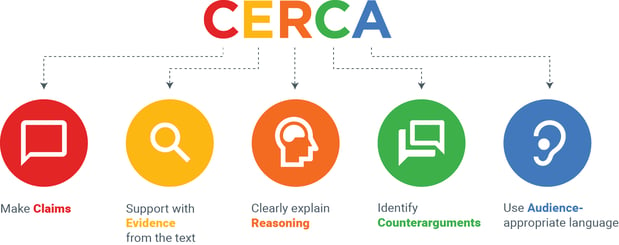
Why CERCA is a More Rigorous Writing Framework than RACE
For starters, CERCA requires students to connect their chosen evidence to their claim.

RACE is a popular writing framework for students to use as they prepare to tackle extended response questions on standardized tests. Here's how it works. RACE stands for:
- Restate – Students restate the question in the form of a topic sentence.
- Answer – Students answer all parts of the question.
- Cite – Students cite examples from the text that support their answer.
- Explain – Students explain their evidence.
The designers of the CERCA Framework, on the other hand, developed a process that is more aligned with the language found in assessment questions, the rigor of new standards, and the demands of life outside of school. Using the CERCA Framework, students learn how to make a Claim (restating the question is a fine way to go there!), provide Evidence from the text, and explain their Reasoning.
[Download our free CERCA poster >>]
CERCA is a more rigorous approach because it pushes students beyond simply restating the text and answering a question.
First off, the claim step in CERCA accounts for the first two steps in RACE. While RACE requires students to first restate the question before answering it, CERCA combines these steps into one claim, a much more useful tool for navigating real-world texts and arguments.
Additionally, presenting evidence to support your point of view is crucial to developing a strong argument. Both RACE and CERCA require students to use concrete evidence from the text. But what are students doing with that evidence?
The reasoning step is where CERCA really becomes more rigorous than RACE. RACE stops at asking students to explain their evidence. CERCA requires students to connect their chosen evidence to their claim. When students have to explain their reasoning, they are more likely to engage critically with the text.
We prefer CERCA because students spend the majority of their time on explaining why the evidence from the text supports the claim.
The following table summarizes how to use the CERCA Framework to tackle extended response questions. For an extra push, ask your students to engage in the rest of the framework by addressing Counterarguments, and using Audience-appropriate language in their final essay.
Using the CERCA Framework to Practice Extended Response Questions
| CERCA Component | What Do I Write? | How Much Do I Write? | ||
| Use a complete sentence based on the question and write a claim. | 1 sentence | |||
| Select the best two pieces of evidence from the text to support your claim. Underline the evidence. | 2 pieces of evidence from the text | |||
| Make a quote sandwich for each piece of evidence. Use reason for your claim and evidence from the text. | 2 quote sandwiches |
For some extra rigor, finish the CERCA Framework!
| Include one reason why others might disagree with your claim, then prove them wrong. | 1 different point of view | |||
| Revise your work to ensure you’re using audience appropriate language | Use audience appropriate language throughout your entire piece. |

As Senior Editor at ThinkCERCA, Catherine brings a variety of experience in classroom teaching, test prep, and content development to her role at ThinkCERCA.
Catherine began her career in education as a Match Corps Urban Education Fellow in Boston, working as a full-time tutor and teaching assistant in a high performing charter school. After completing her fellowship year, she taught science at KIPP WAYS Academy in Atlanta, GA. She also spent two summers teaching high school biology at Deerfield Academy in Massachusetts.
Catherine earned a masters in education from Teachers College at Columbia University. Her research focused on the cognitive underpinnings of teaching and learning. After working as a freelance content developer and editor, she is thrilled to join the team in a full-time capacity.

